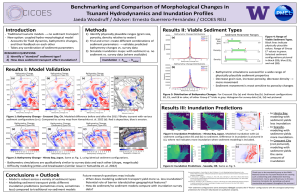
Jaeda Woodruff
Princeton University
Research Mentor: Ernesto Guerrero-Fernández
Project: Hydrodynamic influence of sediment transport in tsunami waves
Hi! My name is Jaeda Woodruff and I’m a Geosciences major at Princeton University. This summer I worked with Ernesto Guerrero-Fernández to study the influence of sediment transport on tsunamis!
Traditional tsunami models assume the seafloor is an unmovable bed—that sand stays more or less where it is. However, that’s not entirely true. Tsunami waves can move a lot of sand, impacting the bathymetry (depth) of the seafloor. So, do those changes in bathymetry impact flooding predictions?
The first part of the project was to validate a new morpho-hydrodynamic model, which accounts for the movement of sand, the movement of water, and the feedbacks they have on each other. We first tested the model against bathymetry survey data in Crescent City, California and Hirota Bay, Japan using a variety of sand types (different combinations of grain size, density, and porosity). The model was robust to sediment type, outputting reasonable bathymetry predictions for a range of different sediment types in different locations. This finding tells us that, although different beaches have different types of sand in real life, we don’t have to know the exact sand type of a given location to get a good bathymetry prediction.
The second part of the project was to understand how modeling sediment movement impacts flooding predictions. To do this, we ran the model with sediment and without sediment for a variety of locations. In Hirota Bay, Japan, modeling with sediment yielded very different flooding predictions, with some regions exhibiting up to 15 meters less flooding when sediment was taken into account. In other locations, like Seaside, Oregon, the opposite behavior was observed—up to 5 meters more flooding when sediment was taken into account. The key takeaway here was that modeling sediment transport has a fairly large impact on flooding predictions, though the impact is not the same for every location and may depend on factors like local geography, distance from source, and/or size of the tsunami event.
In the future, we plan to compare sediment and no-sediment models to available flooding survey data to determine whether sediment transport may improve flooding predictions. Survey data is limited, but preliminary analysis suggests that it can.
Working with Dr. Guerrero-Fernández and the NOAA Center for Tsunami Research group this summer was an amazing experience–everyone I met at NOAA and through CICOES was incredibly welcoming and supportive. It was a great learning experience, as I was able to improve my coding skills, work hands-on with a geophysical model, and talk to tons of researchers, grad students, and interns doing cool oceanography work. To anyone considering applying…do it!

